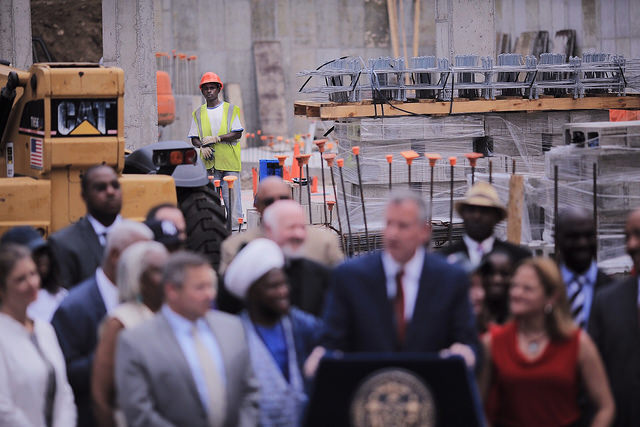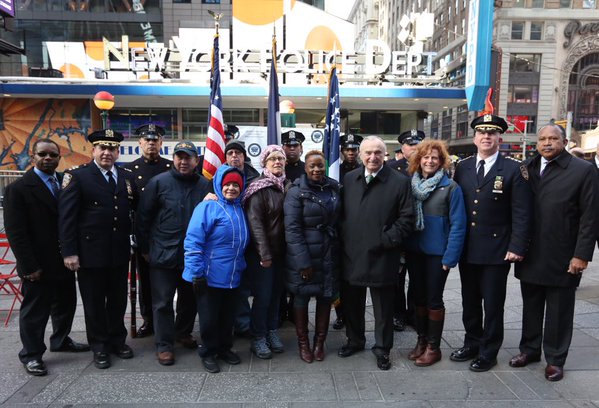Give New York Manufacturers the Space They Need

photo: William Alatriste
In November, New York City Mayor Bill de Blasio and City Council Speaker Melissa Mark-Viverito released a manufacturing policy that makes a strong commitment to the city’s Industrial Business Zones (IBZs). This is the culmination of a growing consensus among certain sectors of the city, from the Progressive Caucus of the City Council to the Hotel Trades Council the editorial board of Crain’s NY Business.
The ten-point plan includes investments in city-owned manufacturing facilities such as the Navy Yard, the creation of a shared advanced manufacturing incubation space, and, controversially, strengthening the prohibition of residential uses within IBZs. Naturally, however, some developers and real estate investors are skeptical, according to Politico New York:
"Several developers…were predictably troubled by the idea that they could not build apartments and condos in these zones … “There are areas of the city that manufacturing is never going to return to. With the housing crisis being what it is, it doesn’t make sense to preserve them for jobs that aren’t coming,” said one developer."
Steve Cuozzo at the Post goes farther, calling it “delusional:”
"What’s looney is the misallocated priority. While the city moves at a snail’s pace to rezone East Midtown, chief engine of the city’s tax base, and buries shopkeepers and small businesses under an avalanche of fines and regulations, it’s throwing the kitchen sink into massaging a sector that counts for peanuts in relation to a financial-, media- and service-driven economy."
As outlined by Saskia Sassen in The Global City, New York’s economy today, like most global cities, is built on producer services like finance, law, and marketing, which make New York into a command-and-control center for the global economy. When Cuozzo tells us to focus on rezoning East Midtown and the “financial- media- and service-driven economy” that operates there, he is arguing that New York should further specialize in producer services, on the assumption that they can sustain the city’s economy and finances indefinitely.
It’s natural to ask, why not? Why make space for manufacturing, when other sectors are contributing so much to the region’s economy, and with affordable housing in such short supply?
For one, cities need manufacturing. Urban production is a self-sustaining engine of prosperity. Not large-scale industrial monocultures like the Detroit auto industry in the “big three” era, but a large variety of small manufacturers buying and selling to one another, like New York’s economy was built on.
As Jane Jacobs argues in The Economy of Cities and Cities and the Wealth of Nations, with support from many economists, cities grow and thrive when small enterprises start producing things they previously imported from other cities, creating new markets for suppliers, maintenance, and distributors, while creating knowledge spillovers that lead to new innovation. The cycle continues as the new imports are replaced in turn. This cycle, she argues, is the very process of economic development.
Jacobs even went so far as to criticize Mayor Bloomberg’s rezoning of Greenpoint and Williamsburg in the last year of her long life, in part because it robbed the neighborhood of manufacturing land. Even Bloomberg recognized the importance of production, since his administration created the IBZs and, with great success, redeveloped the Brooklyn Navy Yard as a productive manufacturing space.
Producer services may result in high profits, but the majority of working-class jobs they create are precarious, low-wage service jobs. Without manufacturing jobs to fill the gap, workers can’t keep up with the rising rents and fares on the paltry wages they make mopping floors and mixing lattes. Fighting back against that inequality, whether through struggles for a $15 minimum wage, against racist police violence, and to preserve and expand affordable housing are crucial. So is building a stronger, more sustainable economic base for working-class New Yorkers.
To create that base, the city must reserve space for job-creating production to occur. Forget the market balancing supply and demand: in such a hot market, there is more demand for various land uses than the city will ever have the square footage to supply. Without public action, only the highest-margin uses will win out, so reserving space for manufacturing, just as it does for affordable housing, is exactly what the city should be doing. Affordable housing, public services, and manufacturing all contribute to the needs, prosperity and culture of the city, but if they are caught in a bidding war with finance and high-end real estate, they will lose. The city isn’t just a space to consume, it’s a place to produce.
***
Matthew Rigney is a Master of City and Regional Planning Candidate at Rutgers University.
***
Have an op-ed idea or submission for Gotham Gazette? Email This email address is being protected from spambots. You need JavaScript enabled to view it.
Criminal Justice Reform Act is No Alternative to Broken Windows Policing

NYPD ceremony in Times Square (photo: @CommissBratton)
Monday morning the City Council will begin consideration of a series of bills, called the Criminal Justice Reform Act, which would limit the use of criminal penalties to manage a variety of low level “quality of life” offenses such as public drinking, park code violations, noise, and public urination. City Council Member Vanessa Gibson, chair of the public safety committee, said she hopes these changes will reduce the problem of excessive criminalization in communities of color, a sentiment echoed by Council Member Rory Lancman, chair of the courts committee, on WNYC radio last Friday. Lancman noted that too many areas of the city have experienced overpolicing and overcriminalization.
The Act, being spearheaded by Council Speaker Melissa Mark-Viverito, already has broad support in the Council and the endorsement of NYPD Commissioner Bill Bratton, and thus, Mayor de Blasio. It's encouraging that political leaders in New York City are exploring ways of reducing the impact of the criminal justice system on communities of color, but this package of reforms is at best a baby step, and at worst, may open the door to more racially discriminatory police actions.
The bills, if passed, would create new civil penalty options for these offences by allowing police to choose between a criminal summons and a civil one when encountering an offender, a choice made based on departmental guidelines. The criminal codes remain on the books per Bratton’s insistence, which he says is necessary so that officers can demand identification, conduct searches, and perform background checks.
With a criminal summons, people must appear in summons court and if they fail to do so a warrant is issued for their arrest. Over a million such arrest warrants are currently on the books, leading to numerous unfortunate encounters with the police, such as being arrested on the way to work or to pick children up from school.
The new civil process, to be administered by the city’s Office of Administrative Trials and Hearings, will be more like traffic court in which people must pay a fine or perform community service, but no warrant will result from failure to comply. Instead, a civil judgement will be issued, which could result in the garnishment of wages or bank accounts, or seizure of property. This might also affect one’s credit rating. None of this will result in incarceration, which is positive, but the penalties can still be substantial, with fines ranging from $25 to $250 for a first offense.
In addition, these financial penalties are likely to fall heaviest on areas where quality-of-life, or broken windows, enforcement is the most widespread, removing resources from already poor communities. While some will escape these penalties through community service programs, many working poor will not.
Vincent Riggins, chair of the public safety committee of Community Board 5 in East New York has actually called for the return of half of all those fines to the local community board to be spent on community development projects. It is a great idea that would reduce the financial incentive that has driven excessive and discriminatory summonsing in places like Ferguson, MO.
Riggins has raised another important point. By leaving these offenses on the books, rather than truly decriminalizing them, the door is left open for the kinds of invasive policing experienced under stop, question, and frisk in recent years. By keeping open alcohol an offense, police will have “reasonable suspicion” to stop anyone drinking a beverage in a bag or unmarked container, potentially leading to exactly the kinds of unwarranted police intrusions that we have worked so hard to reduce. While Bratton rightly touts reductions in police enforcement encounters, racial disparities persist.
Another area of concern is the discretionary nature of the new rules. The NYPD insisted that it would only support the bill if it retained the ability to treat these offences as criminal when officers felt it appropriate. This gives them the ability to demand ID and run people for warrants. But what will determine who gets a civil summons, who gets a criminal one, and who gets run for warrants? There is a real risk that the more punitive practices will become heavily concentrated in exactly those poor, non-white communities that bore the brunt of stop, question, and frisk, and who bear the burden of most criminal summonses and low level arrests now.
Council Member Gibson says that there will be a process of determining policies for guiding officer discretion, and that the City Council is calling for the default to be a civil summons. This outcome, however, is far from assured, since the ultimate decision rests with the NYPD and the officer on the street. Therefore, there is a real risk that the police will perceive the need to take harsher and more invasive action in exactly the same places they do now, with milder penalties reserved for more prosperous parts of the city. If these changes are enacted, this must be monitored closely, something Council Members Jumaane Williams and Mark Levine are proposing through a bill mandating reporting by the NYPD.
Any reduction in the use of criminal penalties is welcome, but this measure retains an adherence to using punitive mechanisms to manage so called quality-of-life problems in keeping with the deeply conservative Broken Windows theory. There is nothing in the bill to develop non-punitive mechanisms for addressing community problems.
As one caller to WNYC pointed out, the current criminal penalties seem to be largely ineffective in reducing the amount of public urination, why should the civil penalties be any more effective? They won’t. The reality is that public bathrooms are largely non-existent in New York City. Other major cities around the world have much more developed amenities in place and have largely avoided this problem. If you don’t want people to pee in public, give them functional and accessible public bathrooms, not a choice between criminal and civil sanctions.
In addition, a lot of quality-of-life problems are driven by pervasive underemployment for youth of color, a lack of positive social activities for young people, and widespread homelessness. While the Mayor and City Council have started to acknowledge the extent of some of these problems, their focus has been primarily on hiring more police and tinkering with what kind of punitive sanctions to use, rather than a major redistribution of resources away from police, courts, and prisons, and towards housing, healthcare, and youth services.
In his book The Silent Black Majority, Michael Fortner shows that the push for criminal justice solutions to community problems was supported by many in poor black communities and my own research on the rise of quality-of-life policing in the ‘90s shows the same thing. But what I also found was that these communities also called for youth centers, improved housing, and better schools, but what they got was only the policing and prisons. It’s time our political leaders quit asking the NYPD for permission to really shift resources away from the criminal justice system and towards improving communities in positive ways.
In Los Angeles, the Youth Justice Coalition has called for redirecting 1% of all criminal justice spending ($100 million) in the county towards youth jobs, community centers, and violence reduction outreach workers. That would be real reform. The Police Reform Organizing Project here in New York is currently exploring a similar initiative on an even broader scale. Crime and disorder matter and need to be addressed, but we must strive to develop affirming rather than punitive solutions whenever possible. If the City Council is serious about reducing the negative impacts of the criminal justice system, it should start by revisiting its decision to expand the NYPD. More police with more discretion is not the answer.
***
Alex S. Vitale is associate professor of sociology at Brooklyn College and author of City of Disorder: How the Quality of Life Campaign Transformed New York Politics. He is senior policy adviser to the Police Reform Organizing Project and serves on the New York State Advisory Committee to the US Civil Rights Commission. You can follow him on Twitter: @avitale
***
Have an op-ed idea or submission for Gotham Gazette? Email This email address is being protected from spambots. You need JavaScript enabled to view it.
Time to Support New York Students with Billions Still Owed from Campaign for Fiscal Equity

Council Member Dromm (middle), the author, at the Queens Library
Governor Andrew Cuomo's recently proposed budget plan for education is a mixed bag, but represents a major shift from his attacks on public education in years past. Ultimately, however, his plan falls short by allocating less than $1 billion in new education money this year at a time when public schools are still owed more than $4.4 billion in Campaign for Fiscal Equity (CFE) funding.
The CFE was a lawsuit brought by parents against the State of New York over a decade ago. These parents charged the State with failing to provide public school students with an adequate education. In 2006, the New York State Court of Appeals ruled in favor of the plaintiffs, finding the State in violation of a student's constitutional right to a "sound and basic education" by underfunding schools.
Nearly ten years later students have still not received the money due to them. The State still owes New York City a staggering $2 billion, leaving our public schools woefully underfunded.
Even the $1.3 billion school aid increase provided in the 2015-16 budget was not enough to restore the massive cuts our schools suffered earlier in the decade. Public schools in immigrant and low-income communities are particularly affected, most of which are owed over 77% of outstanding CFE dollars.
Just imagine the transformative impact a $4.4 billion dollar investment in public education would have on our children's lives. If adequately funded, schools would have the ability to hire additional teachers and school support personnel. Among other things, these sorely needed dollars would provide our students with a more robust physical education and help expand arts education in our schools. These CFE funds would bring about a dramatic reduction in class sizes in New York's most overcrowded school districts. The possibilities are endless.
Credit where credit is due: I am excited that the Governor sees the value of the community school model and recognizes how successful community schools have been in New York City. Supporting students holistically—by offering support groups and child daycare for parents, access to physical and mental healthcare, mentors for students and other valuable services—will make them successful in many ways.
The $100 million he has allocated for community schools is welcome news, but falls short of the $500 million needed considering that these schools have grown exponentially over the past year.
I am hopeful that the Governor's budget plan signifies a renewed interest in public education. But it's high time he settles this ten-year-old debt. New York State must deliver the entire $4.4 billion in CFE funding it owes in order to truly do right by our children. Their futures deserve no less.
***
Daniel Dromm is a City Council member from Queens and chair of the Council Committee on Education. On Twitter @Dromm25.
***
Have an op-ed idea or submission for Gotham Gazette? Email This email address is being protected from spambots. You need JavaScript enabled to view it.




